List of Syrian monarchs

The title King of Syria and Queen of Syria appeared in the second century BC in referring to the Seleucid kings who ruled the entirety of the region of Syria. It was also used to refer to Aramean kings in the Greek translations of the Old Testament; mainly indicating the kings of Aram-Damascus.
Following the defeat of the (Ottoman Empire) in World War I, the region came under the rule of France, United Kingdom and prince Faisal of Hejaz who was proclaimed King of Syria on 8 March 1920. Faisal's reign lasted a few months before he was overthrown by France and the title fell out of use.
Kings and Queens of Syria
Background
The term Syria was first applied by Herodotus in the 5th century BC to indicate a region generally extending between Anatolia and Egypt.[1][2] With the advent of the Hellenistic period, Greeks and their Seleucid dynasty used the term "Syria" to designate the region between the Mediterranean and the Euphrates.[3] The usage of the name in referring to the region during the Iron Age (ended 586 BC) is a modern practice.[1][4]
Seleucid dynasty
The Seleucid king Antiochus III the Great defeated the Ptolemaic Kingdom in the Battle of Panium (200 BC); he annexed the Syrian lands controlled by Egypt and united them with his Syrian lands, thus gaining control of the entirety of Syria.[5] Starting from the 2nd century BC, ancient writers, such as Polybius and Posidonius, began referring to the Seleucid ruler as the king of Syria.[6][7] The evidence for this title's usage by the kings is provided by the inscription of Antigonus son of Menophilus, who described himself as the "admiral of Alexander, king of Syria" (Alexander refers either to Alexander I Balas or Alexander II Zabinas).[7]
| Portrait | Monarch (and lifespan) |
Reign | Consort (and tenure) |
Parents, co-regents, and notes |
|---|---|---|---|---|
 |
Antiochus III the Great (c. 241–187 BC) |
200–187 BC | Laodice III (200–187 BC) Euboea (191–187 BC) |
|
 |
Seleucus IV Philopator (c. 218–175 BC) |
187–175 BC | Laodice IV (187–175 BC) |
|
| Antiochus (c. 180–170 BC) |
175–170 BC |
| ||
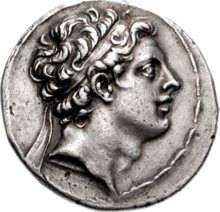 |
Antiochus IV Epiphanes (c. 215–164 BC) |
175–164 BC | Laodice IV (c. 175–c. 164 BC) |
|
 |
Antiochus V Eupator (172–161 BC) |
164–162 BC | Unmarried | |
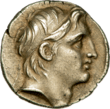 |
Demetrius I Soter (187–150 BC) |
162–150 BC | ||
 |
Alexander I Balas ( -145 BC) |
150–145 BC | Cleopatra Thea (150–145 BC) |
|
 |
Demetrius II Nicator ( –125 BC) |
145–138 BC (first reign) |
Cleopatra Thea (145-138 BC) |
|
 |
Antiochus VI Dionysus (148 BC-142/141 BC) |
144–142/141 BC |
|
Non-dynastic
Diodotus Tryphon who opposed Demetrius II by raising Antiochus VI to the throne killed his protege and declared himself king ruling until 138 when the Seleucids unified Syria again.[22]
| Portrait | Monarch (and lifespan) |
Reign | Consort (and tenure) |
Parents, co-regents, and notes |
|---|---|---|---|---|
 |
Diodotus Tryphon ( -138 BC) |
142/141-138 BC |
|
Seleucid dynasty
| Portrait | Monarch (and lifespan) |
Reign | Consort (and tenure) |
Parents, co-regents, and notes |
|---|---|---|---|---|
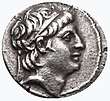 |
Antiochus VII Sidetes ( -129 BC) |
138–129 BC | Cleopatra Thea (138-129 BC) |
|
 |
Demetrius II Nicator ( –125 BC) |
129–125 BC (second reign) |
Cleopatra Thea (129–125 BC) |
|
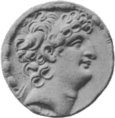 |
Antiochus VIII Grypus ( -96 BC) |
128 BC (first reign) |
||
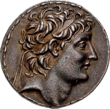 |
Alexander II Zabinas ( -123 BC) |
128–123 BC |
Ptolemaic dynasty
| Portrait | Monarch (and lifespan) |
Reign | Consort (and tenure) |
Parents, co-regents, and notes |
|---|---|---|---|---|
 |
Cleopatra Thea (c. 165-121 BC) |
125-121 BC |
|
Seleucid dynasty
| Portrait | Monarch (and lifespan) |
Reign | Consort (and tenure) |
Parents, co-regents, and notes | ||
|---|---|---|---|---|---|---|
| Seleucus V Philometor ( -125 BC) |
125 BC | |||||
 |
Antiochus VIII Grypus ( -96 BC) |
125-96 BC (second reign) |
Tryphaena (124-111 BC) Cleopatra Selene I (103-96 BC) |
|||
 |
Antiochus IX Cyzicenus ( -95 BC) |
114–95 BC | Cleopatra IV (114-112 BC) Cleopatra Selene I (96-95 BC) |
|||
| Antiochus VIII died in 96 BC and Antiochus IX followed him in 95 BC;[43] the country became embroiled in a civil war in which Antiochus VIII's five sons and the descendants of Antiochus IX fought between themselves.[44] The chronology of all those monarchs is problematic and is specially vague regarding Seleucus VI's successors.[45] | ||||||
 |
Demetrius III Eucaerus ( -88 BC) |
96–88 BC | ||||
 |
Seleucus VI Epiphanes ( -94/93 BC) |
96–94/93 BC | ||||
 |
Antiochus X Eusebes ( -92) |
95–92 BC | Cleopatra Selene I (95–92 BC) |
|||
| Antiochus XI Epiphanes ( -93 BC) |
94–93 BC | |||||
 |
Philip I Philadelphus ( -83 BC) |
94–84/83 BC | ||||
 |
Antiochus XII Dionysus ( -84 BC) |
87–84/83 BC | ||||
| Tigranes II, the king of Armenia, invaded Syria; the year of the invasion is up to debate and is traditionally given as 83 BC based on the account of Appian.[51] The date of the invasion might actually be later, around 74 BC.[54] The Armenian king was forced by the Romans to evacuate Syria in 69 BC.[55] | ||||||
| Seleucus VII Philometer ( -c. 58 BC) |
83–69 BC | Unmarried during reign |
| |||
 |
Antiochus XIII Asiaticus ( -64 BC) |
69–64 BC |
| |||
| Philip II Philoromaeus ( -64 or 56 BC) |
65–64 BC | Unmarried |
| |||
Antonia dynasty
| Name (and lifespan) |
Reign | Consort | Notes |
|---|---|---|---|
| Ptolemy Philadelphus (36-29 BC) |
34-31 BC | Unmarried |
|
Hashemite dynasty
.svg.png)
Following the partitioning of the Ottoman Empire in the aftermath of World War I, Faysal bin Hussein of the House of Hashim was proclaimed King of the Kingdom of Syria on 8 March 1920 in Damascus, following the Arab revolt against the Ottomans of 1916–1918.
His accession was not recognized by France or the United Kingdom who became the new imperial powers in the region, and on 23 July 1920, the French moved 9,000 troops towards Damascus, resulting in the Battle of Maysalun. Faisal was expelled from Syria on 25 July and went into exile in the United Kingdom. On 10 August, the Treaty of Sèvres divided the region into League of Nations mandates governed by France and the United Kingdom.
| Portrait | Name (and lifespan) |
Reign | Consort (and reign) |
Notes |
|---|---|---|---|---|
 |
Faisal (20 May 1885-8 Sept 1933) |
8 Mar 1920 – 24 July 1920 | Huzaima bint Nasser (8 March 1920 – 24 July 1920) |
|
Biblical usage for Aramean kings
In the first translation of the Old Testament into Greek written during the third century BC (called the Septuagint),[61] Aram and Arameans were often translated as Syria and the Syrians;[62][63] hence the king was referred to as the king of Syria,[64] or the king of the Syrians,[65] and this was carried on by many English translations.[62] Aram in the Hebrew Old Testament and Syria in the translation indicated the kingdom of Aram-Damascus most of the times.[62][66] Occasionally, other Aramean regions were also referred to as Syria;[61][66] an example is the character known as "the Syrian of Paddan Aram, the sister of Laban the Syrian" where Syria does not designate Aram-Damascus but rather Paddan Aram in Mesopotamia.[67][68]
According to W. Edward Glenny, the rendering of Aram by Syria might be explained by an anti-Syrian bias, since at the time of the translation, Syria belonged to the Seleucids; the Jews' main enemy. Aram-Damascus was the Jews' enemy during its Iron Age prime in the 9th century BC.[69]
Aramean kings referred to as "kings of Syria"
| Portrait | Name | Reign | Notes |
|---|---|---|---|
| Rezon the Syrian | 10th century BC | Equated by 19th century scholars with another Biblical figure: Hezion.[70] Known only from the Old Testament.[71] | |
| Ben-Hadad I | Known only from the Old Testament.[72] | ||
| Ben-Hadad II | Equated by many Biblical scholars with Adad-Idri who was mentioned in Assyrian sources.[72] | ||
 |
Hazael | c. 842–800 BC[73] | |
| Ben-Hadad III | The only king mentioned by the name "Ben-Hadad" both in the Old Testament and extra biblical sources.[72] | ||
| Rezin | 750s-733 BC | Known in Assyrian inscription as Raqyan.[74] |
See also
| Wikimedia Commons has media related to Monarchs of Syria. |
Notes
- ↑ Antiochus son of Antiochus III was made co-king in 209 BC and died in 193 BC.<ref name='FOOTNOTEGera1998[https://books.google.com/books?id=KDaM1XPv3zYC,<span>,&,</span>,pg=PA283 283]'>Gera 1998, p. 283.
- ↑ There is no reason to believe that Laodice III fell from grace as she survived her husband and was honoured throughout his and his successors reigns.<ref name='FOOTNOTEKosmin2014[https://books.google.com/books?id=9UWdAwAAQBAJ,<span>,&,</span>,pg=PA137 137]'>Kosmin 2014, p. 137.
- ↑ Antiochus was a child of 4 or 5 years when he ascended the throne.<ref name='FOOTNOTECook2004[https://books.google.com/books?id=vIWZDOzfik0C,<span>,&,</span>,pg=PA220 220]'>Cook 2004, p. 220.
- ↑ Appian called Balas Alexandros Nothos (Alexander the bastard); this bastardy could have been the reason for the doubts ancient writers showed regarding Alexander's paternity.[24]
- ↑ Josephus placed Antiochus' murder after the end of Demetrius II's first reign and Diodorus Siculus placed the usurpation of Diodotus Tryphon in the consular year 138 BC.<ref name='FOOTNOTEAtkinson2016[https://books.google.com/books?id=SrfMDAAAQBAJ,<span>,&,</span>,pg=PA41 41]'>Atkinson 2016, p. 41.
- ↑ Alexander fabricated a genealogy that presented him as the son of Alexander I Balas according to Poseidonius, or the adopted son of Antiochus VII according to Justin.[33]
- ↑ In 124/123 BC,<ref name='FOOTNOTEBrijder2014[https://books.google.com/books?id=x-zoBQAAQBAJ,<span>,&,</span>,pg=PA60 60]'>Brijder 2014, p. 60.
- ↑ His reign might have actually ended in 89/88 BC.[48]
- ↑ Philip's death date is unknown but traditionally assumed to be the year 84 or 83 BC.[51] Although there is a possibility that he ruled until 75 BC.[52]
References
Citations
- 1 2 Trevor Bryce (2009). The Routledge Handbook of the Peoples and Places of Ancient Western Asia: From the Early Bronze Age to the Fall of the Persian Empire. p. 680. ISBN 9780415394857.
- ↑ Herodotus; George Rawlinson (1862). History of Herodotus, Volume 1. p. 126.
- ↑ Daniel Pipes (1992). Greater Syria: The History of an Ambition. p. 13. ISBN 9780195363043.
- ↑ Margreet L. Steiner; Ann E. Killebrew (2014). The Oxford Handbook of the Archaeology of the Levant: c. 8000-332 BCE. p. 94. ISBN 9780191662546.
- ↑ Kosmin 2014, p. 122.
- ↑ Nigel Wilson (2013). Encyclopedia of Ancient Greece. p. 652. ISBN 9781136788000.
- 1 2 Kosmin 2014, p. 112.
- ↑ Bunbury 1872, p. 719.
- ↑ Alten 2017, p. 27.
- ↑ Gera 1998, p. 283.
- 1 2 3 4 Kosmin 2014, p. 137.
- ↑ Vehlow 2013, p. 145.
- 1 2 Ogden 2017, p. 241.
- 1 2 3 Gera 1998, p. 110.
- 1 2 Gera 1998, p. 115.
- ↑ Georganas 2016, p. 106.
- ↑ Iossif & Lorber 2007, p. 68.
- ↑ Hazel 2002, p. 20.
- 1 2 Hoover 2000, p. 107.
- ↑ Hazel 2002, p. 73.
- 1 2 3 4 5 6 7 Chrubasik 2016, p. XXIV.
- 1 2 3 4 5 Kosmin 2014, p. 22.
- ↑ Chrubasik 2016, p. 162.
- ↑ Wright 2011, p. 43.
- ↑ Ogden 1999, pp. 45-46.
- ↑ Atkinson 2016, p. 29.
- 1 2 Hazel 2002, p. 21.
- ↑ Atkinson 2016, p. 41.
- ↑ Atkinson 2016, p. 43.
- ↑ Hoover 2000, p. 108.
- 1 2 Atkinson 2012, p. 114.
- ↑ Houghton 1993, pp. 88.
- 1 2 Shayegan 2003, p. 96.
- ↑ Kosmin 2014, p. 23.
- ↑ Burstein 2007, p. 78.
- ↑ Schürer 2014, p. 133.
- ↑ Mcauley 2017, p. 90.
- ↑ Whitehorne 2002, p. 165.
- 1 2 Downey 2015, p. 129.
- ↑ Whitehorne 2002, p. 166.
- ↑ Atkinson 2012, p. 114, 115.
- ↑ Whitehorne 2002, p. 165, 167.
- ↑ Whitehorne 2002, p. 167.
- ↑ Kosmin 2014, p. 243.
- ↑ Hoover 2007, pp. 284, 289.
- 1 2 Downey 2015, p. 133.
- ↑ Hoover 2007, pp. 288.
- ↑ Hoover 2007, pp. 294.
- ↑ Whitehorne 2002, p. 168.
- 1 2 Houghton 1987, pp. 79.
- 1 2 Hoover 2007, p. 296.
- ↑ Hoover 2007, p. 298.
- ↑ Hoover 2007, pp. 298, 299.
- ↑ Hoover 2007, p. 297.
- ↑ Hoover 2007, p. 299.
- ↑ Manaseryan, Ruben (1985). "Տիգրան Բ [Tigran II]". Armenian Soviet Encyclopedia (in Armenian). 11. Yerevan: Armenian Encyclopedia Publishing. pp. 697–698.
- 1 2 "Cleopatra Selene queen of Syria".
- ↑ Cicero, In C. Verrem II 4.61, Appian, Syriaca VIII 49, XI 70, Justin, Historiarum Philippicarum T. Pompeii Trogi XL 2.2 (says Antiochus IX was his father). See also: C.J. Bennett, art. Cleopatra Selene queen of Syria, in Egyptian Royal Genealogy, 2002-2008 (n. 28).
- ↑ Cicero, In Verrem actio 4.61-68
- ↑ David Konstan (2006). Greeks on Greekness: Viewing the Greek Past Under the Roman Empire. p. 6. ISBN 9780906014288.
- 1 2 Paul V.M. Flesher; Bruce D. Chilton (2011). The Targums: A Critical Introduction. p. 339. ISBN 9789004217690.
- 1 2 3 Bruce M. Metzger; Michael David Coogan (1993). The Oxford Companion to the Bible. p. 44. ISBN 9780199743919.
- ↑ James Strong; John McClintock (1867). Cyclopaedia of Biblical, Theological, and Ecclesiastical Literature, Volume 1. p. 353.
- ↑ Adam Clarke (1851). The Holy Bible Containing the Old and New Testaments: the Text Printed from the Most Correct Copies of the Present Authorized Translation, Including the Marginal Readings and Parallel Texts: Genesis to Esther. p. 843.
- ↑ Gerard Gertoux (2015). Kings David and Solomon: Chronological, Historical and Archaeological Evidence. p. 103. ISBN 9781329698109.
- 1 2 Thomas Nelson (2014). NIV, The Chronological Study Bible. p. 622. ISBN 9781401680138.
- ↑ Thomas Nelson (2013). KJV Study Bible: Second Edition. p. 52. ISBN 9781418589141.
- ↑ Brian Schultz (2009). Conquering the World: The War Scroll (1QM) Reconsidered. p. 191. ISBN 9004168206.
- ↑ Edward Glenny (2009). Finding Meaning in the Text: Translation Technique and Theology in the Septuagint of Amos. p. 152. ISBN 9789047429821.
- ↑ Ronald F. Youngblood (2014). Nelson's Illustrated Bible Dictionary: New and Enhanced Edition. p. 1099.
- ↑ Trevor Bryce (2012). The World of The Neo-Hittite Kingdoms: A Political and Military History. p. 178.
- 1 2 3 Richard D. Nelson (2014). Historical Roots of the Old Testament (1200–63 BCE). p. 109.
- ↑ David Noel Freedman; Allen C. Myers (31 December 2000). Eerdmans Dictionary of the Bible. Amsterdam University Press. p. 84. ISBN 978-90-5356-503-2.
- ↑ Jeffrey Kah-Jin Kuan (2016). Neo-Assyrian Historical Inscriptions and Syria-Palestine: Israelite/Judean-Tyrian-Damascene Political and Commercial Relations in the Ninth-Eighth Centuries BCE. p. 125.
Sources
- Sartre, Maurice (2005). The Middle East Under Rome. Harvard University Press. ISBN 978-0-674-01683-5.
- Burgess, Michael Roy (2004). "The Moon Is A Harsh Mistress– The Rise and Fall of Cleopatra II Selene, Seleukid Queen of Syria". The Celator. Kerry K. Wetterstrom. 18 (3). ISSN 1048-0986.
- Kritt, Brian (2002). "Numismatic Evidence For A New Seleucid King: Seleucus (VII) Philometor". The Celator. Kerry K. Wetterstrom. 16 (4). ISSN 1048-0986.
- Houghton, Arthur (1993). "The reigns of Antiochus VIII and Antiochus IX at Antioch and Tarsus". Schweizerische Numismatische Rundschau. Schweizerischen Numismatischen Gesellschaft. 72. ISSN 0035-4163.
- Houghton, Arthur (1987). "The Double Portrait Coins of Antiochus XI and Philip I: a Seleucid Mint at Beroea?". Schweizerische Numismatische Rundschau. Schweizerischen Numismatischen Gesellschaft. 66. ISSN 0035-4163.
- Hoover, Oliver (2007). "A Revised Chronology for the Late Seleucids at Antioch (121/0-64 BC)". Historia: Zeitschrift für Alte Geschichte. Franz Steiner Verlag. 56 (3). ISSN 0018-2311.
- Whitehorne, John (2002) [1994]. Cleopatras. Routledge. ISBN 978-0-415-05806-3.
- Brijder, Herman A.G. (2014). Nemrud Dagi: Recent Archaeological Research and Preservation and Restoration Activities in the Tomb Sanctuary on Mount Nemrud. Walter de Gruyter. ISBN 978-1-614-51622-4.
- Downey, Glanville (2015) [1961]. History of Antioch. Princeton University Press. ISBN 978-1-4008-7773-7.
- McAuley, Alex (2017). "Mother Knows Best: Motherhood and Succession in the Seleucid Realm". In Cooper, Dana; Phelan, Claire. Motherhood in Antiquity. Palgrave Macmillan. ISBN 978-3-319-48902-5.
- Schürer, Emil (2014) [1973]. Vermes, Geza; Millar, Fergus, eds. The History of the Jewish People in the Age of Jesus Christ (175 B.C.-A.D. 135). 1 (A New English Version ed.). Bloomsbury. ISBN 978-1-472-55827-5.
- Burstein, Stanley Mayer (2007) [2004]. The Reign of Cleopatra. University of Oklahoma Press. ISBN 978-0-806-13871-8.
- Atkinson, Kenneth (2012). Queen Salome: Jerusalem’s Warrior Monarch of the First Century B.C.E. McFarland & Company. ISBN 978-0-786-49073-8.
- Shayegan, M. Rahim (2003). "On Demetrius II Nicator's Arsacid Captivity and Second Rule". Bulletin of the Asia Institute. Wayne State University Press. 17. ISSN 0890-4464.
- Atkinson, Kenneth (2016). A History of the Hasmonean State: Josephus and Beyond. T&T Clark Jewish and Christian Texts. 23. Bloomsbury Publishing. ISBN 978-0-567-66903-2.
- Ogden, Daniel (1999). Polygamy, Prostitutes and Death: The Hellenistic Dynasties. Duckworth with the Classical Press of Wales. ISBN 978-0-715-62930-7.
- Wright, Nicholas L. (2011). "The Iconography of Succession Under the Late Seleukids". Coins from Asia Minor and the East: Selections from the Colin E. Pitchfork Collection. Ancient Coins in Australian Collections. 2. Numismatic Association of Australia. ISBN 978-0-646-55051-0.
- Gera, Dov (1998). Judaea and Mediterranean Politics: 219 to 161 B.C.E. Brill's Series in Jewish Studies. 8. Brill. ISBN 978-9-004-09441-3. ISSN 0926-2261.
- Chrubasik, Boris (2016). Kings and Usurpers in the Seleukid Empire: The Men who Would be King. Oxford University Press. ISBN 978-0-198-78692-4.
- Hoover, Oliver D. (2000). "A Dedication to Aphrodite Epekoos for Demetrius I Soter and His Family". Zeitschrift für Papyrologie und Epigraphik. Dr. Rudolf Habelt GmbH. 131. ISSN 0084-5388.
- Iossif, Panagiotis; Lorber, Catharine (2007). "Laodikai and the Goddess Nikephoros". L'antiquité Classique. Association L'Antiquité Classique. 76 (1). ISSN 2295-9076.
- Hazel, John (2002) [2000]. Who's Who in the Greek World. Routledge. ISBN 978-1-134-80224-1.
- Georganas, Ioannis (2016). "Antiochus IV Epiphanes". In Phang, Sara E.; Spence, Iain; Kelly, Douglas; Londey, Peter. Conflict in Ancient Greece and Rome: The Definitive Political, Social, and Military Encyclopedia. ABC-CLIO. ISBN 978-1-610-69020-1.
- Cook, John Granger (2004). The Interpretation of the Old Testament in Greco-Roman Paganism. Studien und Texte zu Antike und Christentum. 23. Mohr Siebeck. ISBN 978-1-107-16478-9. ISSN 1436-3003.
- Ogden, Daniel (2017). The Legend of Seleucus: Kingship, Narrative and Mythmaking in the Ancient World. Cambridge University Press. ISBN 978-1-107-16478-9.
- Vehlow, Katja (2013). Abraham Ibn Daud's Dorot 'Olam (Generations of the Ages). A Critical Edition and Translation of Zikhron Divrey Romi, Divrey Malkhey Yisraʾel, and the Midrash on Zechariah. The Medieval and Early Modern Iberian World. 50. Brill. ISBN 978-9-004-22790-3. ISSN 1569-1934.
- Bunbury, Edward Herbert (1872). "Laodice". In Smith, William. A Dictionary of Greek and Roman Biography and Mythology. II. John Murray. OCLC 9176630.
- Alten, Elif (2017). "Revolt of Achaeus Against Antiochus III the Great and the Siege of Sardis, Based on Classical Textual, Epigraphic and Numismatic Evidence". In Laflı, Ergün; Kan Şahin, Gülseren. Archaeology and History of Lydia from the Early Lydian Period to Late Antiquity (8th century B.C.-6th century A.D.). An international Symposium May 17-18, 2017 / Izmir, Turkey. Abstracts Booklet. Colloquia Anatolica et Aegaea, Acta Congressus Communis Omnium Gentium Smyrnae. IV. The Research Center for the Archaeology of Western Anatolia – EKVAM. OCLC 6848755244.
- Kosmin, Paul J. (2014). The Land of the Elephant Kings: Space, Territory, and Ideology in the Seleucid Empire. Harvard University Press. ISBN 978-0-674-72882-0.